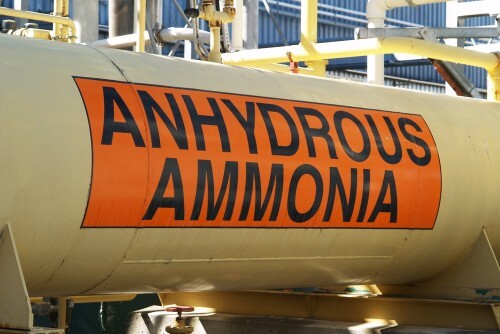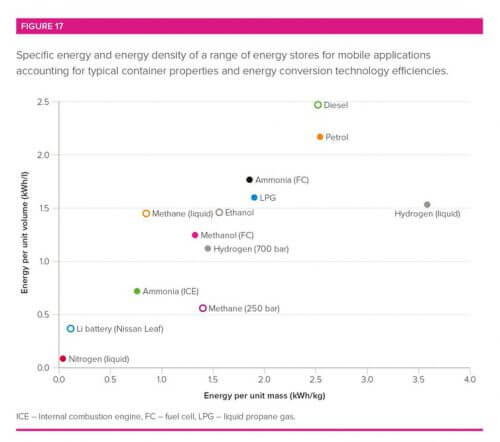Ammonia is the second most important molecule after water, but its production is the third largest source of carbon dioxide emissions in the world, an emission at a rate of 1.8% of total global emissions. A green way to produce it will help attack the climate crisis from several directions
By Bill David, Professor of Chemistry, University of Oxford

[Translation by Dr. Moshe Nachmani]
Over the past century, a simple molecule has had a particularly positive impact on our world. Ammonia, which consists of three hydrogen atoms bonded to one nitrogen atom, is a substance that is widely used for the production of fertilizers that allow us to produce food required for all of humanity. This fact makes ammonia the most important molecule in our world, after water
Along with the importance of this molecule, the production of ammonia constitutes the world's third largest source of carbon dioxide emissions, an emission at the rate of 1.8% of total global emissions.
Today, ammonia is produced by a reaction between methane and water vapor, a reaction that produces hydrogen, and then a reaction of this hydrogen with nitrogen from the air - a process known as Haber-Bosch. This process also creates carbon dioxide as a byproduct, a substance that is a greenhouse gas. In contrast, "green" ammonia is produced by hydrogen separated from water by using electricity obtained from a renewable energy source. In addition, the ammonia can be broken down back into its components (hydrogen and nitrogen) and within this process receive energy. Ammonia can also be used as a fossil fuel, for example diesel; That is, ammonia can also be used as an important energy source.
The Rutherford Appleton Laboratory, located in Oxfordshire (a county in the South East of England), has developed a demonstration system for "green" ammonia. It is operated by a turbine located on the site itself and which is capable of producing up to 30 kg of green ammonia per day. In addition, it is able to feed electricity back into the electricity grid, depending on the demand. The main challenge in producing green ammonia as a viable alternative is reducing the cost, eighty-five percent of which comes from the cost of electricity. In most parts of the world, renewable energy is still significantly more expensive than the methane used as a feedstock in the normal production of ammonia.
At the same time, the cost of electricity in areas where there is extensive potential for the utilization of renewable energy has decreased significantly over the past decades and reached a cost of NIS 7-15 per kWh. That is, it is possible to produce green ammonia at a cost of NIS 360 per ton. This cost is still far from the cost of the normal process. However, in order to use this method while reducing emissions into the air, we will have to incorporate carbon capture and storage so that the carbon dioxide obtained in the process does not reach the atmosphere. And here green ammonia can be financially competitive.
Green ammonia also has the ability to overcome one of the biggest unsolved challenges in the pursuit of the vision of zero emissions - how do we create flexible fuel reserves that emit zero carbon dioxide, reserves that will be preserved for many years? Ammonia can be easily stored in large quantities in liquid form at moderate pressures (15-10 times our atmosphere) or refrigerated at minus thirty-three degrees Celsius. In this form, the energy density is around half that of gasoline and ten times that of batteries.
The relative advantage of ammonia compared to other fuel alternatives lies in the fact that there is already a global production and distribution system for it thanks to its widespread use as a raw material for making fertilizers. In addition, there is already a comprehensive network of ports capable of handling ammonia in large quantities so that it can be used as a fuel that can be distributed over large distances with relative ease. In fact, the international shipping industry has already demonstrated the feasibility of using ammonia as a transportable fuel in large cargo ships. The MAN Energy Solutions company, which designs and manufactures marine engines, announced that the first ammonia engine could be put into use as early as the beginning of 2022. This would also provide opportunities for the development of green fuel for trains, heavy trucks and even airplanes that do not emit carbon dioxide at all.
At the same time, ammonia poses other challenges. The use of ammonia-based fertilizers contributes to the global reduction in biodiversity, worsens air quality problems and increases greenhouse gas emissions. New uses of ammonia will have to include effective measures to prevent further emissions into the already polluted air. Stricter control measures must be implemented than those already implemented in all industrial sites that store ammonia, this is to ensure that the risks of ammonia leakage, and consequently the emission of harmful nitrogen oxides into the open air, will be as negligible as possible. What needs to be done today is to research and demonstrate the potential of ammonia, starting with improving the systems that generate electricity from the wind and the sun and ending with optimizing the production and storage of green ammonia. And in addition, to develop comprehensive processes for converting ammonia back into energy at the required place and time.

For an article in The Conversation
More of the topic in Hayadan:
- Ammonia production from atmospheric nitrogen has become simpler thanks to an innovative catalyst
- An innovative approach to ammonia production based on renewable energy
- Israeli researchers have developed a cheap, environmentally friendly and safer technology for producing hydrogen
- The State Comptroller calls for considering the removal of the polluting factories from Haifa Bay

3 תגובות
This way we will gain three things:
1. Greener energy?
2. Farmers will explode here and there (less humans, more green).
3. Less fertilizers for agriculture (less people, more green did we say?)
A bit strange article, firstly the energy production increases are very old, taken 20 years ago. The cost of creating a kilowatt of solar energy, for example in Israel has reached an increase of under 15 cents per kilowatt, in the world it has already reached 5. That is, one tenth of what is written in the article. Secondly, it is not clear how energy can be extracted from ammonia, which is probably the essence of the matter.
Everything looks green except that ammonia is very toxic and its leakage is very dangerous